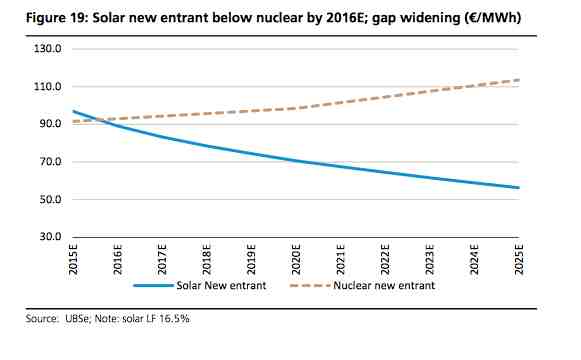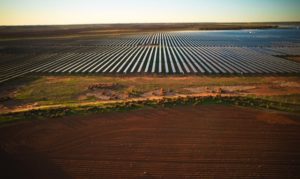Early this week we ran a report on the latest UBS analysis, which suggested that solar could displace both coal and nuclear energy as the world’s “default” source of power and could account for one quarter of global capacity and 10 per cent of output by 2050.
It turns out, however, that this was the investment’s bank’s “middle scenario”. In keeping with the global trend of underestimating solar, UBS concedes that this forecast could prove conservative.
“In cooperation with the MIT, we investigate the main constraints on “scaling up solar” (land, raw material, social pressure on tariffs) and conclude that solar could potentially power the entire planet without any land or material bottleneck,” it writes.
It presents four four scenarios ranging from low solar penetration (5% of global output), a mid-case scenario (10% penetration), a high scenario (25%) and a “Dream” scenario of 50%. (Click on table to enlarge).
“Taking our mid-scenario, we can see that the solar PV market could increase by 14 times from current levels,” the analysts write. “On this basis, global solar installed base would be 3,000GW, or about half of today’s total installed base (renewables as well as conventional) in the world, and 1⁄4 of the total capacity by then.”
The dream scenario would would lift total solar invesetment in solar from around $3 trillion in the mid scenario to $US14 trillion. It says there are no resource limits to silicon based solar panels, although there might be for thin-film modules because of restraints on the supply of tellurium, gallium and indium.
And what is the cost to consumers of these forecasts? Virtually nothing.
UBS estimates that global subsidies will could reach a peak of about €70bn in 2025, but would then begin to decline as older subsidised plants would leave room to newer and unsubsidised ones. As a reference, 2025 power bills would likely total about €6 trillion. That means the solar subsidies would be the equivalent of just one per cent of power bills at their peak (or 0.03 per cent of global GDP), and falling rapidly.
And the pressure on land resources? Not much.
UBS says one square km could fit 50-100MW of solar PV. “Taking the mid- range, we see that – on our base case 2050 scenario of 10% output penetration (25% of capacity) – solar PV would occupy almost 40,000 sq km, or 0.03% of the total land surface of the globe. Even under the “Dream” scenario of half of global production from solar, the covered surface by modules would be only 0.13%. “
Finance community, industry experts underestimate solar capacity growth
UBS says it wrote the report because it believes the financial community and most industry experts “largely underestimate the global solar capacity growth, as falling costs, supportive regulation and the opening up of new solar markets seems to go largely unnoticed.”
UBS expects large scale solar plants to become the industry standard, displacing centralised generation such as coal-plants and nuclear. Indeed, it expects solar could have as rapid a growth in global capacity as nuclear did in the 1970s and 1980s, but it expects no nuclear renaissance, because solar will beat it on costs.
Interestingly, UBS expects many of the utility-scale solar parks to find direct end customers in the business and industrial world. “Industrial customers, shopping malls or office buildings could be ideal clients, to sign a “fixed price” agreement, such as a PPA,” it writes. This is already occurring with the likes of Google, Apple, IKEA and Wal-Mart.
UBS says the impact of solar will be to transform the global energy markets. Countries will be driven by cheap costs, the removal of fuel price risk, and the benefits of energy security.
Solar, by 2020, will be the cheapest form of “new build”. Profit margins for thermal electricity (coal and nuclear) will drop to zero. Indeed, it says availability-subsidies will be needed to avoid mass scale closures.
UBS says battery storage development will go hand in hand with solar, but while costs are likely to fall 75 per cent over the next decade, it cannot see a case for significant amounts of grid defection.
This, in turn, presents opportunities for utilities. It sees a $3 trillion opportunity in smart networks, and says utilities will dominate the rollout of solar, in contrast to developments to date where they have taken only a minor role.
“We believe that most of the “hidden value” in the utilities space lies in power distribution and in global renewable platforms (even though currently largely devoted to developing wind) as these will soon be converted into ‘solar springboards’ and fuel larger than expected growth.”














